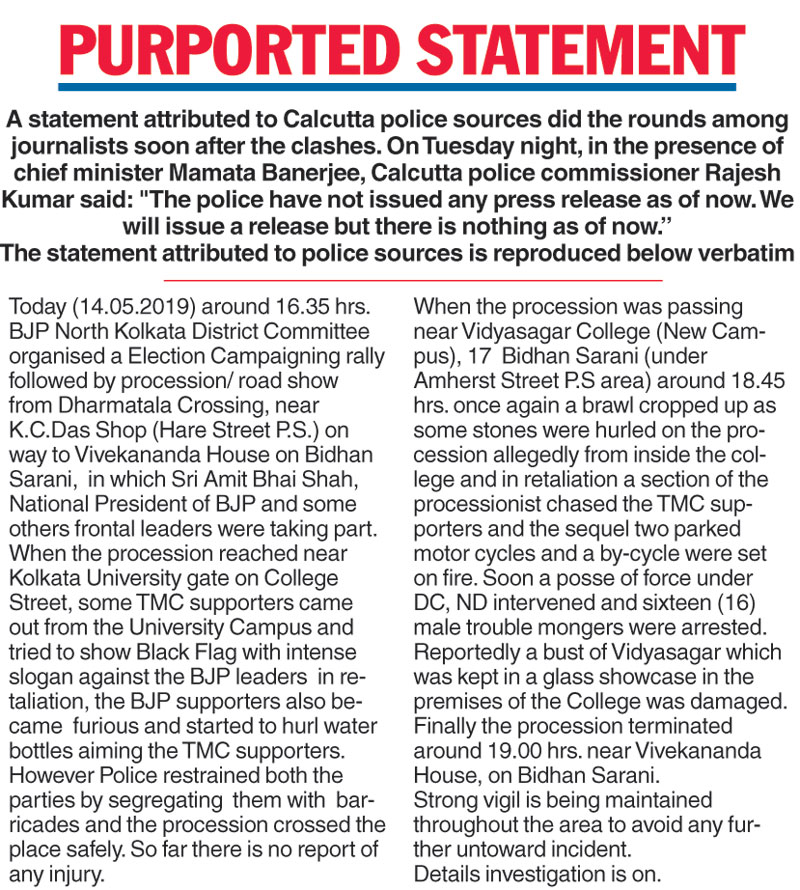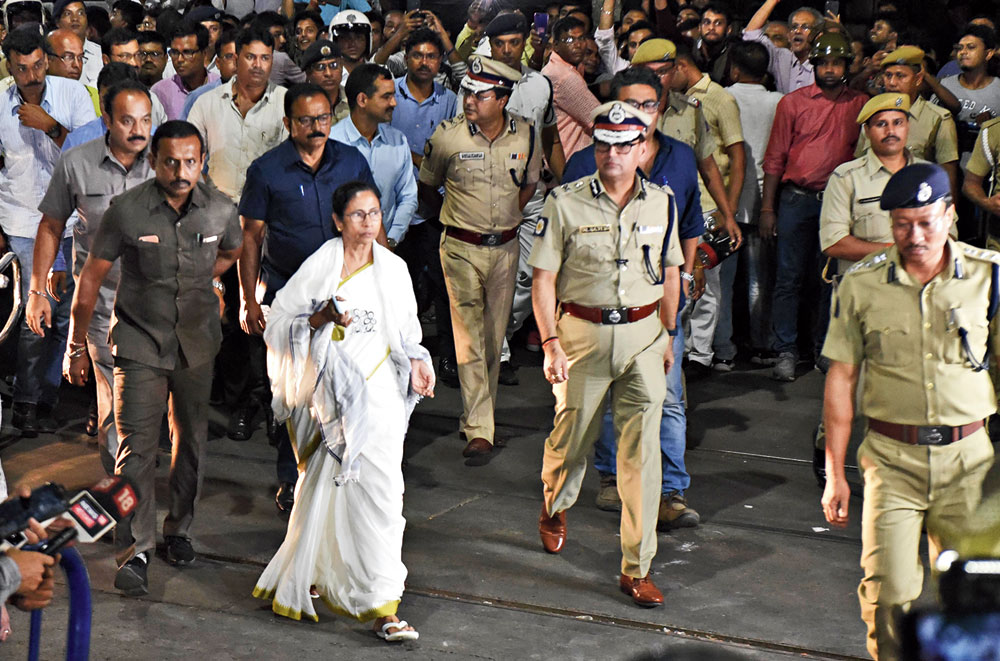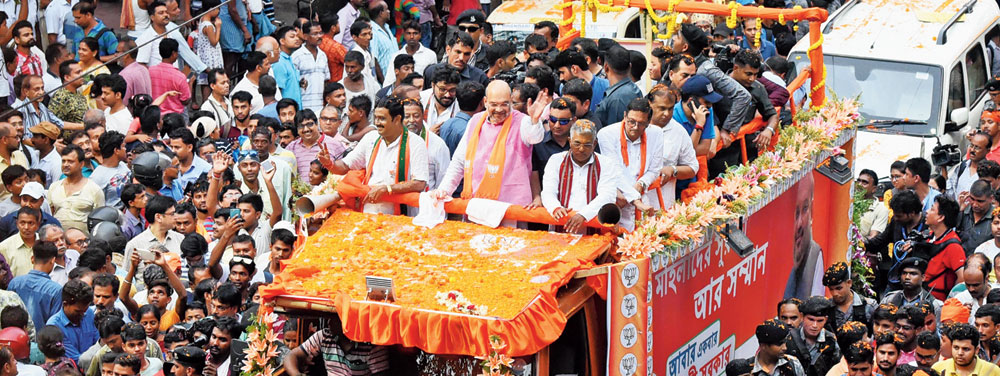The College Street flare-up during BJP president Amit Shah’s road show could have been averted had there been proper planning on the part of police, a former Calcutta police commissioner has said.
The College Street-Bidhan Sarani stretch in north Calcutta has always been “vulnerable” to sudden outbursts, including political clashes involving college and university students.
Elaborate arrangements should have been made for Shah’s road show to avoid trouble, former police commissioner Prasun Mukherjee told The Telegraph on Tuesday evening.
As the Lok Sabha elections are on, the police are now under the Election Commission of India.
“There should have been deployment of static forces at possible flashpoints on the stretch between College Street and Bidhan Sarani to ensure no one came on to the street and mixed with those joining the road show,” Mukherjee said.
The former officer based his assessment on television footage that showed scores of people from near the university gate spilling onto the road while Shah’s cavalcade was passing through College Street.
Eyewitness said BJP and Trinamul supporters had gathered around the main gate of Calcutta University around 4pm. Even before the road show started from Esplanade, there was tension at College Street, bookstall owners told this newspaper.
“Didn’t this information reach the top bosses at Lalbazar?” Mukherjee asked.
According to a senior police officer, the assembly around the university could have been checked had top cops placed a static force on the pavements of College Street.
Eyewitnesses said there was no major force mobilisation in the area. Besides, the guardrails — placed to separate the onlookers from those taking part in the procession —were too weak for such a large gathering.
Mukherjee, who was the police commissioner of Calcutta for three years from 2004, said it was a “sad” day and wondered if officers at the ground level had floundered in tackling the situation.
“A procession like that of Amit Shah in Calcutta should have been covered like any religious procession, with forces placed in the front, back and both sides to ensure none could suddenly join the rally,” Mukherjee said.
He said officers at the ground level probably dithered because of lack of communication from the top.
When the Election Commission replaced the Calcutta police commissioner and posted IPS officer Rajesh Kumar as the city’s top cop, chief minister Mamata Banerjee had written to the panel about purported lapses in the process.
Mamata had pointed out that Kumar did not have any experience in Calcutta police and ideally, the commission should have sought the names of three officers from the state government and chosen the commissioner from among them.
“The new police commissioner is a very good officer, but he has never worked for Calcutta police,” Mukherjee said.
Commissioner Kumar and other senior officers at Lalbazar were holding a meeting with Election Commission officials when Shah’s rally began. Kumar and other senior officers went to Vidyasagar College after learning about the vandalism.
Another element was added when a statement attributed to Calcutta police sources circulated among journalists.
The statement said “when the procession reached near Kolkata University gate on College Street, some TMC supporters came out from the University Campus and tried to show Black Flag with intense slogan against the BJP leaders…. In retaliation, the BJP supporters also became furious and started to hurl water bottles aiming the TMC supporters.”
Formal media releases by the police immediately after a flare-up by and large refrains from mentioning the names of political parties, especially until the picture is clear. The message attributed to the police identified the political parties by name and mentioned their roles in the flare-up.
Commissioner Kumar, in the presence of Mamata at the site of the vandalism at Vidyasagar College, denied that the police had issued any official media release after she asked him whether any such message was circulated.
“The police have not issued any media release as of now. We will issue a release but there is nothing as of now,” he said.

The Telegraph
Sources present at the spot claimed that the chief minister, during a brief conversation with the commissioner, expressed displeasure with the release.
“From a distance, it could be seen that she was gesticulating and chiding and the commissioner was nodding,” said a source.
Soon after, Mamata took the microphone and addressed the media near the Vidyasagar College campus on Bidhan Sarani. Asked by the chief minister, Kumar, too, spoke.
“I just want to say this: Ishwarchandra Vidyasagar is worshipped by all of us. He is the pride of entire India, not only Bengal. We will not spare anybody and ensure full action. More than 100 people have already been detained. We are probing who among them were involved. We will not spare anybody,” the officer said.
A section of the police feels Tuesday’s incident had exposed how lack of guidance to the Calcutta police’s rank and file could affect the law and order in the city.

Mamata leaves Vidyasagar College for Calcutta University, accompanied by city police commissioner Rajesh Kumar (to her left), on Tuesday Picture by Sanat Kumar Sinha
“Had there been proper deployment along the route, the Vidyasagar College incident could have been averted. Instead of blaming trouble-mongers, there is a need to introspect why they could not be stopped,” a retired IPS officer said.
Former commissioner Mukherjee said: “The officers, including assistant commissioners of police, who were at the ground would have felt confident and empowered to handle any situation if they had orders from superior officers.”
Mukherjee said the police should have firmly dealt with the situation right at the onset and there should have been clear instructions for taking action. “Irrespective of political affiliation, there should have been a crackdown. Were the orders missing? I don’t know,” Mukherjee said.
A former police commissioner said it was important for the top cop to know the city’s geography and also have a clear idea of the officers in the force.
“The CP has to have previous working knowledge in Calcutta police. The CP must know which officer can handle what type of situation and accordingly decide on deployment. There are officers who handle law-and-order situations and others who are good at investigation,” he said.
“Similarly, a CP should know the landmarks along a rally route and where trouble can break out,” the former commissioner added.











